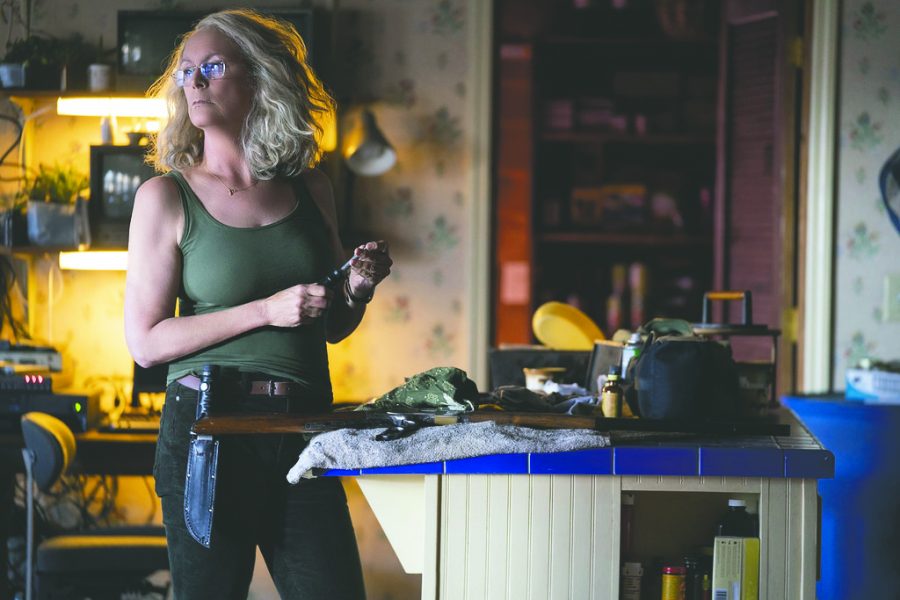Halloween (2018) is an unexpected success following its 1978 predecessor
Jamie Lee Curtis reprising her role as Laurie Strode in the 2018 Halloween sequel.
November 4, 2018
While not the first of its genre, John Carpenter’s low-budget 1978 film Halloween became the standard to which all other slasher movies are compared.
The first of 11 entries in the series was far from the most violent the genre has to offer, but the idea of an unstoppable murderer that is part man, part evil continues to inspire rip-offs to this day. David Gordon Green’s new Halloween is built on the original’s horrifying core and is at its best when it limits its deviations.
Set 40 years after the first film, Halloween takes the route of 2009’s Friday the 13th and disregards all of the other sequels. Michael Myers, aka The Shape, has been locked away in a sanitarium since his rampage on Halloween 1978. Laurie Strode (Jaime Lee Curtis), who narrowly escaped Michael that night, has passed her years locking herself in a heavily fortified home, stocking up on weapons and building traps in anticipation of the Boogeyman’s eventual return.
This obsession brought on by PTSD cost Laurie her relationship with her daughter Karen (Judy Greer), which her granddaughter Allyson (Andi Matichak) hopes to mend. Of course, Michael does escape, and the Strode family must learn to survive together while the masked murderer quickly resumes his killing spree.
Halloween is more than a simple horror movie because of its look at how different people respond to tragedy fueled by hatred. Michael’s new psychiatrist, Dr. Sartain (Haluk Bilginer), has dedicated his career to understanding what makes the murderer tick, two podcasters (Rhian Rees and Jefferson Hall) use the legendary story of the 1978 murders for profit, Karen writes off her mother’s attack as one dark moment in an otherwise good world, Laurie has let her fear turn into her own hate, and Allyson has not yet figured out how she feels fitting into her grandmother’s legacy of terror. By the film’s logic, only one of these reactions is the correct answer, and it will take until the climactic confrontation to figure out which one is.
For this dynamic to work, Halloween includes a lot of characters, many of whom are only featured in one or two scenes. Normally this would not be a proble, since horror movies tend to include one-dimensional characters just for the sake of having them killed off, but it sometimes feels like the movie wants to do more with them than it does. Side characters like Allyson’s boyfriend get such a heavy focus only to have nothing to do with the plot in the end.
One of the reasons it is disappointing to see so many characters disappear from the story is because of how good all of the performances are. The highlight is obviously Jaime Lee Curtis in a paranoid, angry take on her debut role. Bilginer’s psychiatrist is a welcome new character since he has not yet given up on Michael like series regular Dr. Loomis, though he fails to bring the energy to the role that Donald Pleasence did.
Dr. Sartain is one of many examples of how Halloween adapted classic roles and scenes from the first movie in a creative way. Some of the kills and exact shots from the original return, but they fit flawlessly into the new narrative. Homages like masks from Halloween III and an encounter in a restroom reminiscent of H20 give fans things to keep a look out for without the movie going out of its way to cram in references.
The horror elements of this movie are done better than just about any other slasher flick. Not every death occurs onscreen, and while the movie does feature some incredibly graphic violence it never reaches the surreal heights that make so many other slashers funnier than they are scary.
Michael’s murders made up the most confusing aspect of the film, but it pulls together to make it all the scarier. The Shape sometimes stalks a person seemingly at random, but then sometimes ignores easy targets. Unofficial rules about who gets to live and die in a horror movie are frequently broken, and there is no clear pattern to who Michael singles out as targets, but his slow, careful movements and arrangements of dead bodies make every kill seem intentional.
Michael Myers proves himself for the first time in 40 years as the quintessential horror villain not because he has no motive, but because his motive is buried so deep within a corrupt mind that no viewer can dig it up.
Michael has not lacked an explained motive since the original Halloween, so the return to form feels in place with John Carpenter’s return to the series for the first time since 1982. Though his role was as a consultant and composer, the 2018 Halloween feels like it came straight from the soul of the franchise’s creator and nobody else.
This 2018 sequel is Michael Myers and the slasher genre at its absolute scariest. Though the final scene lingers a little longer than it should and the story does overflow with characters, the spotlight is never truly stolen from the Strode ladies led by the ultimate scream queen pushed to her limit.
Halloween earns a 9.5/10.



